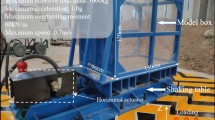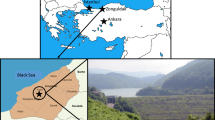Abstract
The failure of a large dam can be catastrophic to human life and property downstream. Therefore, the seismic safety is of particular concern for high dams in seismically active regions. This paper addresses the nonlinear seismic response analysis of high arch dams due to spatially-varying ground motions. Firstly, a comprehensive analysis model developed at Tsinghua University is presented, which takes into account radiation damping effect of semi-unbounded canyon, dynamic interaction of dam-water, opening of contraction joints, seismic damage cracking and strengthening of dam concrete, and nonlinearity of foundation rock. Subsequently, the seismic damage of Pacoima dam during the 1994 Northridge earthquake is qualitatively analyzed by the developed analysis model. The results agree with the actual damage observed after the earthquake. Most of the contraction joints opened and closed during the earthquake, and a larger residual opening occurred at the thrust block joint after the earthquake. The cracks continue from the bottom of the thrust block joint in three directions: diagonal, horizontal, and vertical. Finally, a large-scale numerical simulation of seismic ground motion from source rupture to dam canyon is introduced, which can simulate the characteristics of near-field ground motions at dam sites by considering the effect of source mechanism, propagation media, and local site.









Similar content being viewed by others
References
Zhang C, Jin F, Pekau OA (1995) Time Domain procedure of FE-BE-IBE coupling for seismic interaction of arch dams and canyon. Earthq Eng Struct Dyn 24:1651–1666
Maeso O, Aznarez JJ, Dominguez J (2004) Three-dimensional models of reservoir sediment and effects on the seismic response of arch dams. Earthq Eng Struct Dyn 33(10):1103–1123
Du X, Tu J (2007) Nonlinear seismic response analysis of arch dam-foundation systems-part II opening and closing contact joints. Bull Earthq Eng 5:121–133
Wang J, Chopra AK (2010) Linear analysis of concrete arch dams including dam-water-foundation rock interaction considering spatially varying ground motions. Earthq Eng Struct Dyn 39(7):731–750
Wang J, Lv D, Jin F, Zhang C (2013) Earthquake damage analysis of arch dams considering dam-water-foundation interaction. Soil Dyn Earthq Eng 49:64–74
Alembagheri M, Ghaemian M (2013) Damage assessment of a concrete arch dam through nonlinear incremental dynamic analysis. Soil Dyn Earthq Eng 44:127–137
Mircevska V, Nastev M, Hristovski V, Bulajic I (2014) Arch dam-fluid interaction considering reservoir topology. J Earthq Eng 18(7):1083–1101
Omidi O, Lotfi V (2017) Seismic plastic–damage analysis of mass concrete blocks in arch dams including contraction and peripheral joints. Soil Dyn Earthq Eng 95:118–137
Chopra AK, Wang J (2010) Earthquake response of arch dams to spatially-varying ground motion. Earthq Eng Struct Dyn 39(8):887–906
Yang J, Jin F, Wang J, Kou L (2017) System identification and modal analysis of an arch dam based on earthquake response records. Soil Dyn Earthq Eng 92:109–121
He C, Wang J, Zhang C, Jin F (2015) Simulation of broadband seismic ground motions at dam canyons by using a deterministic numerical approach. Soil Dyn Earthq Eng 76:136–144
Wang J, He C, zhang C (2017) Large-scale wave propagation simulation from fault rupture to dam structures. In: Proceedings of 16th World Conference on Earthquake Engineering, Paper No. 3311, Santiago Chile
Zhang C, Pan J, Wang J (2009) Influence of seismic input mechanisms and radiation on arch dam response. Soil Dyn Earthq Eng 29(9):1282–1293
Pan J, Zhang C, Wang J, Xu Y (2009) Seismic damage-cracking analysis of arch dams using different earthquake input mechanisms. Sci China Ser E Technol Sci 52:518–529
Wang J, Zhang C, Jin F (2012) Nonlinear earthquake analysis of high arch dam-water-foundation rock systems. Earthq Eng Struct Dyn 41(7):1157–1176
Long Y, Zhang C, Jin F (2008) Numerical simulation of reinforcement strengthening for high-arch dams to resist strong earthquakes. Earthq Eng Struct Dyn 37:1739–1761
Pan J, Xu Y, Jin F, Wang J (2015) Seismic stability assessment of an arch dam-foundation system. Earthq Eng Eng Vib 14(3):517–526
Song L, Wu M, Wang J, Xu Y (2016) Seismic damage analysis of the outlet piers of arch dams using the finite element sub-model method. Earthq Eng Eng Vib 15(3):617–626
Liu J, Li B (2005) A unified viscous-spring artificial boundary for 3-D static and dynamic applications. Sci China Ser E Eng Mater Sci 48(5):570–584
ABAQUS Inc (2007) Abaqus theory manual. Version 6.7. ABAQUS, Inc., Providence
Bathe KJ, Chaudhary A (1985) A solution method for planar and axisymmetric contact problems. Int J Numer Methods Eng 21(1):65–88
Lee JL, Fenves GL (1998) Plastic-damage model for cyclic loading of concrete structures. J Eng Mech ASCE 124(3):892–900
Ghanaat Y (2004) Failure modes approach to safety evaluation of dams. In: Proceedings of 13th World Conference on Earthquake Engineering, Paper No. 1115, Vancouver, Canada
Acknowledgements
The authors gratefully acknowledge the financial supports provided by the National Natural Science Foundation of China, under Granted nos. 51639006 and 51725901. Appreciation is expressed to Prof. Yan-Jie Xu and Dr. Jian-Wen Pan for their valuable discussion and suggestions. The authors are also grateful to Professor Anil K. Chopra, University of California at Berkeley, for helpful advice and comments on the earthquake input models.
Author information
Authors and Affiliations
Corresponding author
Rights and permissions
About this article
Cite this article
Wang, JT., Jin, F. & Zhang, CH. Nonlinear Seismic Response Analysis of High Arch Dams to Spatially-Varying Ground motions. Int J Civ Eng 17, 487–493 (2019). https://doi.org/10.1007/s40999-018-0310-3
Received:
Accepted:
Published:
Issue Date:
DOI: https://doi.org/10.1007/s40999-018-0310-3




